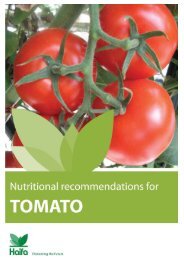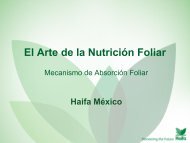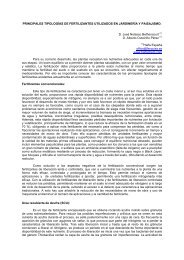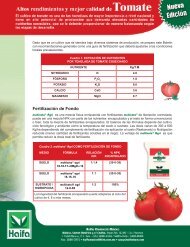Crop Guide: Nutritional recommendations for Cucumber - Haifa-Group
Crop Guide: Nutritional recommendations for Cucumber - Haifa-Group
Crop Guide: Nutritional recommendations for Cucumber - Haifa-Group
Create successful ePaper yourself
Turn your PDF publications into a flip-book with our unique Google optimized e-Paper software.
allowed to develop on the lower 75 cm (30 inches) of the main stem to encourage the plant’s rapid<br />
vegetative development. Main-stem fruits above that point are allowed to develop at the base of<br />
each leaf.<br />
More than one fruit may begin to develop at each node. Some growers thin these to a single<br />
vigorous fruit, but it may be more practical to leave all young fruits attached, because it has been<br />
observed that more than one may mature<br />
Fruit thinning<br />
Overbearing can sometimes be a problem. To prevent the plants becoming exhausted and to<br />
improve fruit size, control the number of the fruit per plant through selective fruit thinning. This<br />
technique is powerful, so use it with great caution. The optimum number of fruits per plant varies<br />
with the cultivar and, even more, with the growing conditions. Although, limiting the number of<br />
fruits per plant invariably results in premium-priced large fruit, growers risk underestimating the<br />
crop's potential or failing to <strong>for</strong>ecast good weather. They may decide to remove too many fruits<br />
and thus unnecessarily limit production. Fruit thinning is undoubtedly most useful in the hands of<br />
experienced growers who can use it to maximize their financial returns. Fruit to be pruned must be<br />
removed as soon as it can be handled, be<strong>for</strong>e it grows too large.<br />
Irrigation<br />
Maximum yields and fruit quality will be realized only if the plants receive adequate and timely<br />
moisture. <strong>Cucumber</strong> plants have shallow roots and require ample soil moisture at all stages of<br />
growth. When fruit begins setting and maturing, adequate moisture becomes especially critical.<br />
The objective of watering is to maintain a fully adequate supply of water to the plant roots without<br />
soaking the soil to the extent that air cannot get to the roots. Do not wait until the plants start to<br />
wilt. A good practice is to dig into the soil and judge how much water remains be<strong>for</strong>e starting the<br />
next irrigation. Regular watering on the same day of the week is unwise. The needs of the plants<br />
change daily and seasonally. Water young plants planted in the greenhouse in January or February<br />
only once every 5-10 days and then only enough to wet 15-20 cm of the soil. Similar plants growing<br />
in June may need 5-10 fold as much water. Let the soil texture and structure determine how much<br />
water to add at each application. By examining the soil be<strong>for</strong>e watering and several hours<br />
thereafter, you can assess the effectiveness of the water application. Depending upon soil type and<br />
growth conditions, approximately 25–50 mm of water per week is needed to obtain high quality<br />
cucumbers. An irregular water supply, particularly during blossoming and fruit development, can<br />
detrimentally affect fruit quality and result in increased nubins or hooked fruit.<br />
The pH of the water is also critical and may need to be adjusted. The target pH of the nutrient<br />
solution supplied to the plants should be between 5.5 and 6.0. Nitric, sulfuric, or phosphoric acid<br />
are recommended <strong>for</strong> reducing the pH if it is above 7. If the source water is alkaline due to high<br />
bicarbonate concentrations, the pH should be adjusted be<strong>for</strong>e the fertilizer salts are added to<br />
prevent precipitation. If it is necessary to raise the pH, potassium hydroxide is usually used.<br />
Important: Irrigation timing should not interfere with pollination and should allow surfaces to dry<br />
be<strong>for</strong>e nightfall.<br />
The drip irrigation system is better than most other conventional soil irrigation systems, because it<br />
can be used to control crop growth by regulating the supply of water and nutrients. The drip<br />
system also allows reduced relative humidity (RH) in the greenhouse, because not all the soil is<br />
irrigated and because the system is compatible with the use of white polyethylene film as a lightreflecting<br />
mulch. In countries suffering from lack of good irrigation water the drip irrigation<br />
18












